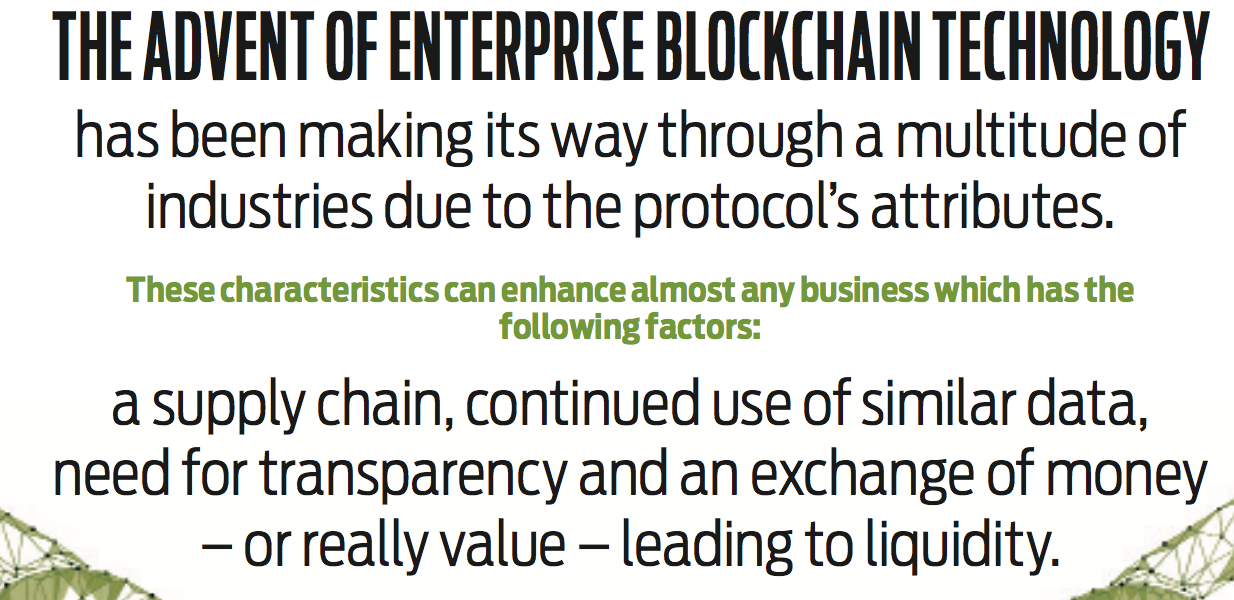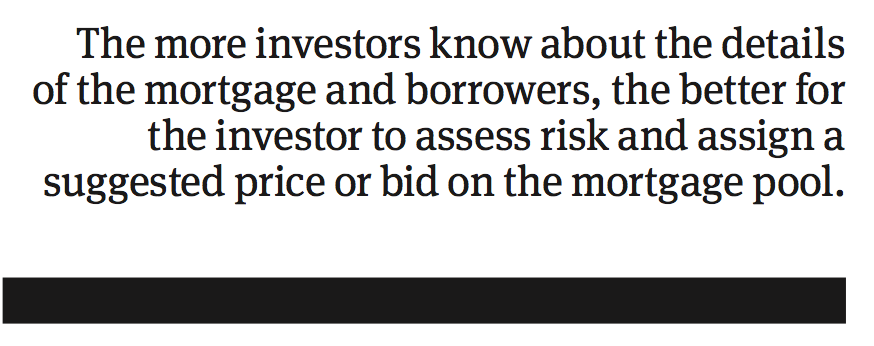Over the course of the past decade, there have been several disruptors in the mortgage industry – advances that include eNotarization, desktop underwriter, Day 1 Certainty and, of course, the digital loan application process. All these improvements have a common factor in that they streamline the mortgage process and ultimately improve the customer experience.
The next step to advancement lies with utilization of blockchain technology. This nascent technology will take all these measures and truly transform the industry from paper to digital, resulting in transparency, better data security and higher revenues from operational efficiencies.
The advent of enterprise blockchain technology has been making its way through a multitude of industries due to the protocol’s attributes. These characteristics can enhance almost any business which has the following factors: a supply chain, continued use of similar data, need for transparency and an  exchange of money – or really value – leading to liquidity. The mortgage industry is no different. Particularly, however, blockchain technology has tremendous potential in transforming capital markets – both globally and nationwide. There are a multitude of methods by which blockchain innovation can be applied to the capital markets industry for benefits across this financial services sector.
exchange of money – or really value – leading to liquidity. The mortgage industry is no different. Particularly, however, blockchain technology has tremendous potential in transforming capital markets – both globally and nationwide. There are a multitude of methods by which blockchain innovation can be applied to the capital markets industry for benefits across this financial services sector.
Explaining Blockchain
Blockchain, a subset of distributed ledger technology or DLT, is essentially a methodology of storing and tracking information on a series of blocks which together form a chain of blocks and resemble a ledger. This ledger is not stored on one server, but on a decentralized database which includes a multitude of computers, or “nodes.” One of the benefits of such a decentralized database is that it sets a higher standard for a cyberattack due to the fact that more than 51% of the computers would have to be simultaneously hacked for such an attack to occur. Furthermore, the decentralized storage of information allows for peer-to-peer business; this means information can be obtained more directly and there may not be a need for a middleman or facilitator of payment or data.
Blockchain protocols also allow for the simultaneous transfer of value (equivalent to money) via electronic currency – sometimes referred to as tokens or cryptocurrency. This could lead to easing of liquidity so long as there is enough supply and demand. Another important benefit of the technology is that data that is entered into a blockchain-based platform can be accessed simultaneously by all users who are given rights to enter the ledger. Data points on a blockchain are therefore retrieved by the user directly from the protocol, as opposed to having to transmit this data among parties. Due to the way the blockchain is architected (in what is called “consensus protocols,” one of which, for example is “Proof of Work”), there is no risk that data could get altered during transfer.
A blockchain has an “append only” feature. This means that information entered onto a blockchain is time and data stamped and cannot be erased. Changes to such information occur in the form of amendments added to the blockchain. If data is entered onto a blockchain and checked for accuracy once, it need not be checked again and the data then contains a single source of truth. Furthermore, blockchain ledgers can be architected in a manner which allows for complete transparency as to who accessed it and when. This results in a comprehensive audit trail without the need to recreate.
The characteristics of blockchain make it an extremely useful emerging technology which continues to improve each day. As such, a number of new blockchain-based protocols have emerged in the first half of 2018 focusing on capital markets. It is likely that the industry will continue to see these initial protocols develop and new blockchain based platforms emerge which will allow for a complete transformation and improvement in the capital markets process.
Capital Markets Today
Capital markets is a broader term associated with a financial ecosystem made up of financial institutions whose focus is to raise or sell capital by dealing with shares, bonds and other longer-term investment vehicles. Capital markets are primarily composed of two different and distinct market sectors: the equity market and the debt market. In the context of the mortgage industry, financial assets (debt) held by mortgage institutions acquired and then traded into asset backed securities. The equity market generally includes stocks, while the debt market includes bonds. Moreover, several different financial institutions operate in capital markets, including stock exchanges, commercial banks, various types of corporations, insurance companies and mortgage banks. A highly liquid capital market is a market that both rapidly and consistently trades in either debt or equity.
Mortgage capital markets is a complex, relationship-driven process that is vital to replacing capital and increasing revenue margins by mortgage companies. Within this realm, when a mortgage loan funds, it gets pooled with other mortgages of the same risk pool – the risk is broken down by credit score, ZIP code, loan-to-value ratio and debt-to-income ratio. Such risk factors are mitigated via the rates assigned to the mortgages and the product types. Larger mortgage lenders will create a pool of their own loans of various risk buckets, and then are sold as a mortgage-backed security to investors. The largest mortgage investors are Fannie Mae and Freddie Mac. They set guidelines to direct mortgage originators on how loans should be underwritten. This is to control the risk and valuation of loan pools.
 How loan level risk is quantified is intimately connected to how familiar loan aggregators are with the information associated to all aspects of the real estate and the borrowers. The more investors know about the details of the mortgage and borrowers, the better for the investor to assess risk and assign a suggested price or bid on the mortgage pool. Traditionally, investors have been limited by the access and visibility of mortgage debt across the United States. More information provided to investors yields a higher confidence assessment in their investment. The greater the confidence, the more investors will pay for mortgage pools. The access and visibility to loan and borrower level details have largely been limited by technology aggregation and distribution factors; blockchain is uniquely organized across industry verticals to safely organize, secure and make accessible to potential investors.
How loan level risk is quantified is intimately connected to how familiar loan aggregators are with the information associated to all aspects of the real estate and the borrowers. The more investors know about the details of the mortgage and borrowers, the better for the investor to assess risk and assign a suggested price or bid on the mortgage pool. Traditionally, investors have been limited by the access and visibility of mortgage debt across the United States. More information provided to investors yields a higher confidence assessment in their investment. The greater the confidence, the more investors will pay for mortgage pools. The access and visibility to loan and borrower level details have largely been limited by technology aggregation and distribution factors; blockchain is uniquely organized across industry verticals to safely organize, secure and make accessible to potential investors.
Integrating Blockchain
Blockchain technology, if integrated into use by capital market firms, can provide efficiencies and other benefits due to the central, permanent and accessible nature of the technology and related smart contracts. Specifically, the technology could help with processes in the trading of loans or bundles, reporting, compliance and credit risk management.
Trading Blockchain technology can be used by firms in the secondary market to source loans and perform due diligence. Using the technology alleviates the need to transfer data and allows for a central depository where buyers and due diligence providers are given permissioned access to the loan level data. Most importantly, using blockchain allows for the same access to transparent data to be accessed by all parties involved during the settlement process.
Blockchain’s central ledger essentially eliminates reconcilement issues in capital market transactions because it creates a single source of truth. Furthermore, the use of blockchain technology allows for an overall reduction in violations concerning trading limits. In capital markets, trading limits are typically set for both notional amounts and settlement dates and if these are not complied with, severe financial penalties could be imposed upon the financial financial institution.
An example of a blockchain company utilizing the technology in the capital markets space is Elphi.io, which, according to founder Eilon Shalev, uses the R3 Corda protocol that creates a secure, decentralized database where information is transparent and agreed upon by all parties involved in the transaction. Shalev notes that “by introducing a secured, trusted and transparent mechanism for reconciling debt transactions, we are able to save creditors and debtors billions of dollars.”
Reporting and Compliance Another use of blockchain is in the market-to-market valuation reporting process, particularly with respect to more swiftly generating trade data, including real-time reports. The inherent features of blockchain can also be used to improve multi-jurisdictional regulatory reporting and provide for a more streamlined and efficient approach with the multitude of reporting requirements faced by firms. As an immutable ledger with time and date  stamps of all transactions between parties, the ledger serves as a recording mechanism for all transactions and is suitable for compliance audits. Utilizing blockchain as a main depository of data and information for financial institutions would also be advantageous to risk departments who could be given transparency into the process via permissioned access (real-time or not) to the ledger.
stamps of all transactions between parties, the ledger serves as a recording mechanism for all transactions and is suitable for compliance audits. Utilizing blockchain as a main depository of data and information for financial institutions would also be advantageous to risk departments who could be given transparency into the process via permissioned access (real-time or not) to the ledger.
Smart Contracts and Credit Risk Management Blockchain could also be implemented in the capital markets space by using the technology to create smart contracts that could be used in various scenarios. Smart contracts essentially codify into the technology an “if/then” scenario or workflow that triggers upon a specific condition. Thus, if there were trading agreements among parties, upon execution of a trade, the technology could be implemented to provide for a streamlined trade settlement process. Smart contracts could also be utilized in escrow scenarios where conditions must be met prior to release of funds.
Finally, blockchain protocols can be utilized to improve credit risk management for financial institutions. The size of the credit line granted to the client of a firm usually depends upon several different factors, including the volatility of the traded asset and the notional size of the transactions. If market conditions change, additional collateral could be required to secure the traded or transferred asset and manage the altered credit risk that resulted from this market change. Smart contracts could be used to write debit funds to satisfy the changed market conditions and the shared blockchain ledger could provide an accessible, central database for the financial institutions.
While there are leaders in the technology of blockchain such as Ethereum, Hyperledger, Corda and Digital Asset, there are not any financial institutions that have emerged as the blockchain leader as it pertains to use in capital markets. Nevertheless, the technology is being implemented in a wide variety of uses across the financial services sector. These range from trading and payment platforms to building databases for properties, loans and borrowers. The use of blockchain technology is exploding across a variety of other sectors and it is only a matter of time before it infiltrates as a common underlying technology protocol within capital markets.
Due to the fact that blockchain has already been successfully implemented a variety of other industries providing for benefits to the the overall efficiency and transparency of these sectors, its implementation in the capital market industry will also prove significantly beneficial. The use and implementation of this emerging technology could provide the capital market with the tools to successfully compete against other growing industries already taking hold of the multifaceted new technology protocol.





